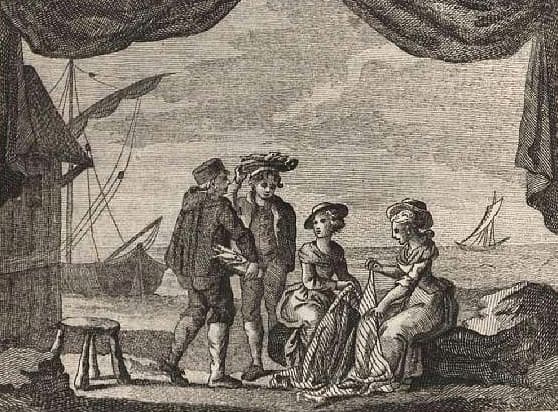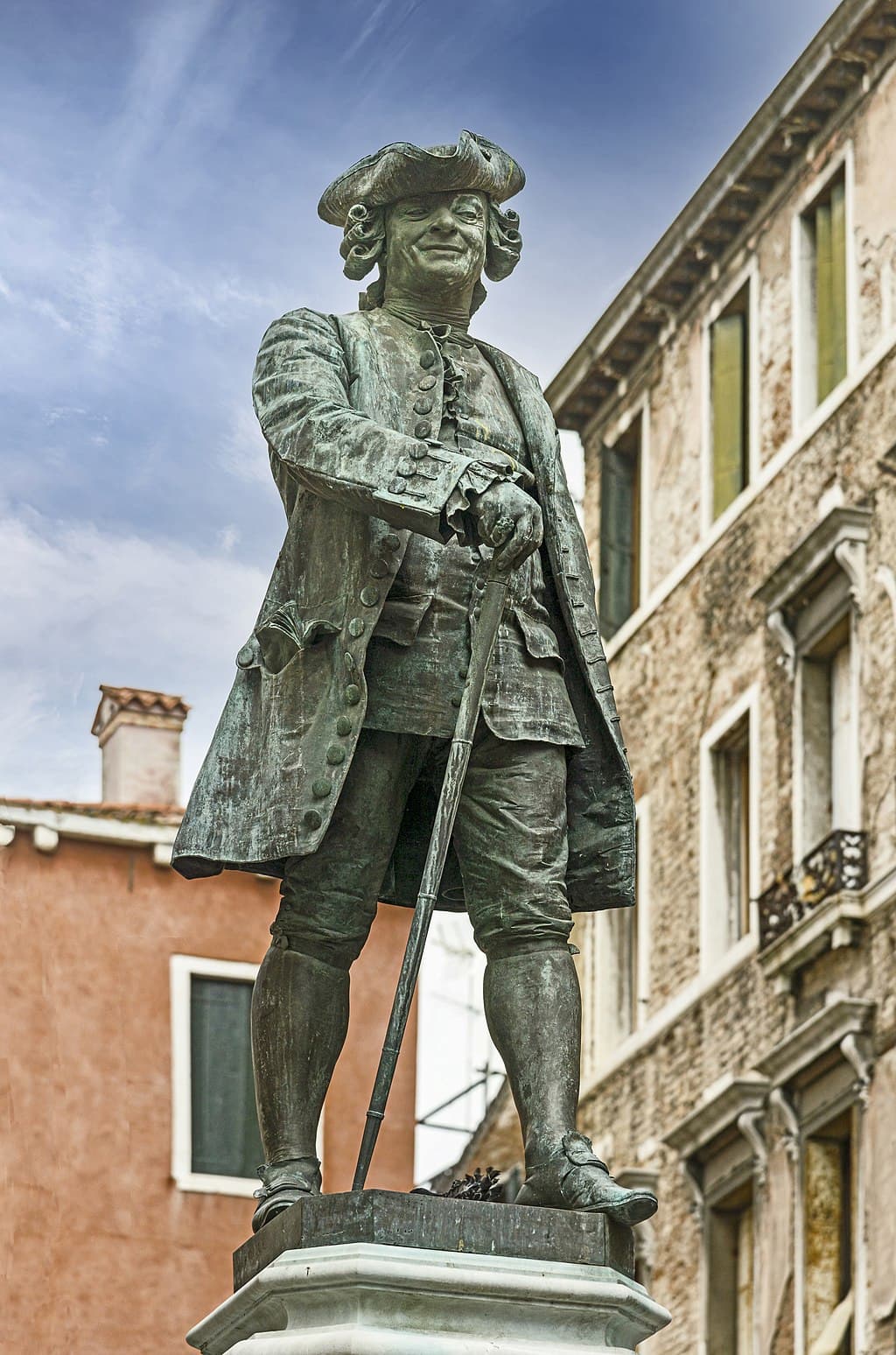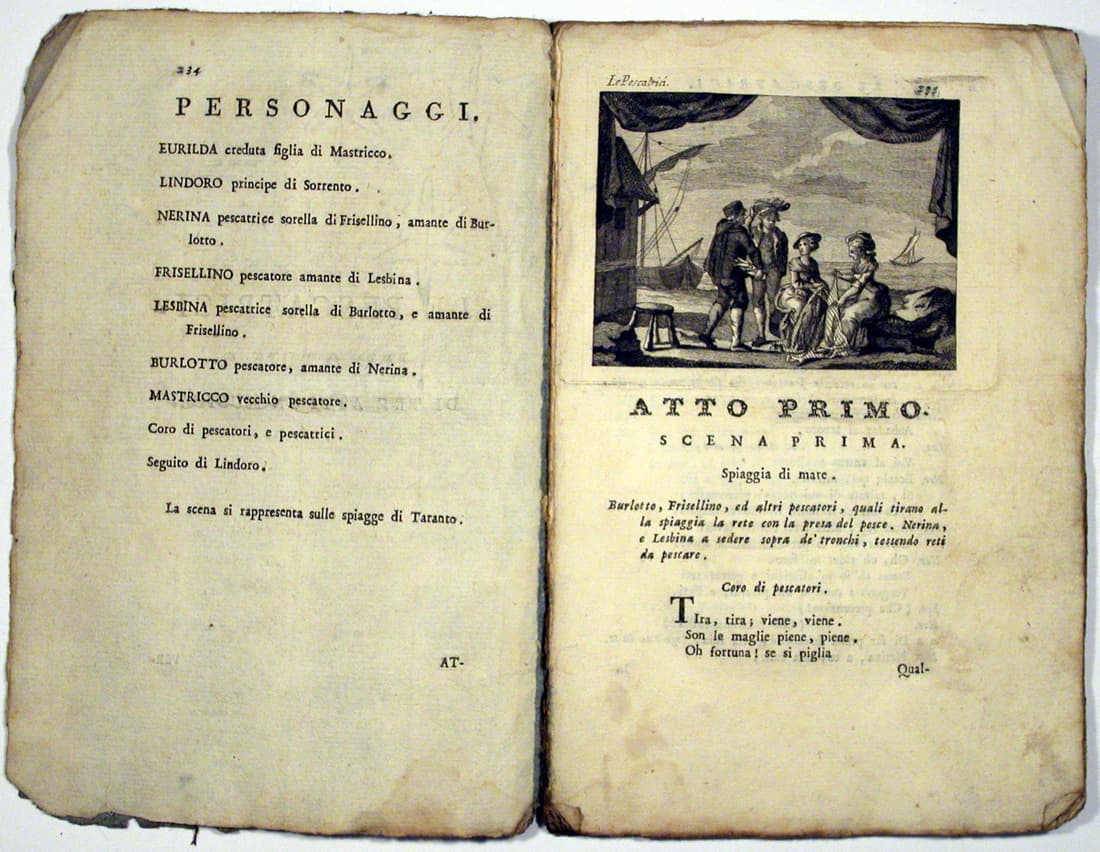Joseph Haydn’s first full-length opera Le Pescatrici (The Fisherwomen) to a libretto of Carlo Goldoni premiered at Eszterháza on 16 September 1770 on the occasion of an elaborate marriage celebration in honour of Countess Lamberg, Prince Nikolaus Esterházy’s niece, and Count Poggi. A large portion of the Haydn score was destroyed in a fire at the opera house in 1779, but it was reconstructed in 1965 by Haydn scholar H.C. Robbins Landon and the composer Karl Heinz Füssel. Since the source situation is somewhat problematic, modern productions are rare.
Joseph Haydn: Le Pescatrici, “Overture”
Carlo Goldoni

Alessandro Longhi: Porträt des Carlo Goldoni
The Goldoni libretto for Le Pescatrici is not really concerned with the topic of actually fishing but with the idyllic concept of pretty women fishing for men’s hearts. As is well known, an entire literary genre, the “ecloghe pescatorie” sprung up for that particular topic. In Goldoni’s play, the satire is directed towards those who aspire to a higher social rank “and in the process assume a pretentious and haughty attitude.” The first extant musical setting dates from 1754 and the pen by Rocco Gioanetti, followed by Haydn in 1770 and Gassmann in 1771.
Haydn’s version of the libretto included five new arias and a rearranged ending and features both comic and serious characters. Of the seven characters, two are from opera seria, the noble-born Eurilda (contralto), raised as the daughter of a fisherman, and Lindoro (bass), Prince of Sorrento. The remaining five are all fishing-folk who live on the shores of Taranto: two pairs of brothers and sisters, Nerina (soprano) and Frisellino (tenor), and Lesbina (soprano) and Burlotto (tenor); and the old fisherman Mastricco (bass), foster parent of Eurilda.
Franz Joseph Haydn: Le pescatrici, Hob.XXVIII:4 – Act I: Tira, tira, viene, viene (Lithuanian Opera Chorus; Lithuanian Opera Orchestra; Olga Geczy, cond.)
Franz Joseph Haydn: Le pescatrici, Hob.XXVIII:4 – Act I: Aria: Tra tuoni, lampi e fulmini (Alexandr Agamirzow, tenor; Lithuanian Opera Orchestra; Olga Geczy, cond.)
The Plot

Illustration of Act 1, Scene 1 of Carlo Goldoni’s Le pescatrici from Carlo Goldoni, le opere teatrali, Vol. XLIV p. 235, published in Venice by Antonio Zatta, 1795.
The story is set in Taranto and concerns the young nobleman Prince Lindoro searching for Prince Casimiro’s rightful heir. The lost princess of Benevento has been taken away as a baby following her father’s murder. As Lindoro arrives in a remote fishing village, the genuine “pescatrici,” Nerina and Lesbina, each claim to be the missing princess. Seeking to marry, they assume aristocratic manners and, in the process, spurn their lovers, Burlotto and Frisellino. Since Lindoro has offered a reward of gold and jewels, Burlotto informs the prince that Lesbina is the lost heiress, and Frisellino does the same by advancing Nerina.
Lindoro finds out that Eurilda, the assumed daughter of the fisherman Mastricco, is of noble birth. Eurilda is shocked as she recognises the dagger used to murder her father, but her “refinement, sensibility, and propensity for feeling, hence virtue, reveal her to be the long-lost princess.” Burlotto and Frisellino, meanwhile, disguise themselves as cavaliers who wish to take Nerina and Lesbina away with them on Lindoro’s ship. The women initially fall for the deception but are disappointed after the suitors reveal their true identities. All is forgiven, however, and the couples are reunited as Lindoro and Eurilda sail away.
Joseph Haydn: Le pescatrici, Hob.XXVIII:4 – Act II: Aria: Ha gl’occhi brillanti (Gyula Littay, tenor; Lithuanian Opera Orchestra; Olga Geczy, cond.)
Joseph Haydn: Le pescatrici, Hob.XXVIII:4 – Act II: Scene: Amici, in ricompensa (Vytautas Juozapaitis, baritone; Laima Jonutyte, contralto; Ramute Tumuliauskaite, soprano; Jolanta Ciurilaite, soprano; Alexandr Agamirzow, tenor; Gyula Littay, tenor; Genedij Bergorulko, bass; Lithuanian Opera Orchestra; Olga Geczy, cond.)
The Premiere

Monument of Carlo Goldoni in Venice
As scholar Caryl Clark writes, “the opera’s main theme is clear: those who are high-born are noble, dignified, honest and morally superior. Clearly, Le pescatrici was an appropriate choice for an elaborate marriage celebration. It also reflects,” according to Clark, “a new kind of operatic subject, one that speaks to the interest of an emerging bourgeois spectator in the inner voice of feeling.”
Haydn had completed the score in 1769, but it was reserved for the aristocratic wedding one year later. Apparently, no expense was spared for this lavish production, and the opera was repeated two days later “to no less generous applause than at the first performance.” In fact, Haydn personally received a cash gift from Prince Nikolaus after the second performance.
Joseph Haydn: Le pescatrici, Hob.XXVIII:4 – Act III: Nume, che al mare (Lithuanian Opera Chorus; Lithuanian Opera Orchestra; Olga Geczy, cond.)
Joseph Haydn: Le pescatrici, Hob.XXVIII:4 – Act III: Aria: Questa mano (Laima Jonutyte, contralto; Lithuanian Opera Orchestra; Olga Geczy, cond.)
The Music

Carlo Goldoni’s Le Pescatrici libretto
Roughly one third of Haydn’s autograph score is missing, and several arias are only partially preserved in the score. Eurilda’s only complete aria, “Questa mano e questa cuore” in Act 3, is a tender love song in which she reveals the depth of her character and unwavering virtue. However, many choruses and vocal ensembles survive, including atmospheric numbers that establish pastoral tranquillity. Also surviving are the opera’s two finales, each featuring a return to the opening theme.
I don’t know how you feel about re-composition, but many have taken H.C. Robbins-Landon to task for trying. As he wrote, “The autograph of the music is no longer quite complete; some beginnings or ends of the arias and recitatives are missing, as is the middle part of Act II, but all the Finales, and all the central numbers—that is, those in which the character of the persons involved is determined—are extant, and our role is no more important in reconstructing the missing section than is that of an expert restorer of antique furniture for whom (as for us) the greatest praise can only be that the final result, the missing leg of the table, is indistinguishable from the rest.”
For more of the best in classical music, sign up for our E-Newsletter
Joseph Haydn: Le pescatrici, Hob.XXVIII:4 – Act III: Soavi zeffiri (Lithuanian Opera Chorus; Lithuanian Opera Orchestra; Olga Geczy, cond.)
